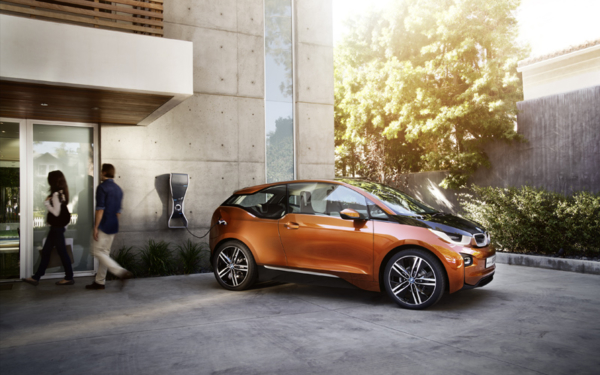
A SELECT few gathered in Leipzig last week to be ushered into the production facility for BMW’s new i-branded, electric car range, the city-focused i3 and the supercar i8.
We came away with a much, much clearer sense of the i3, which –unbelievably- is just months away from hitting UK roads.
With the range extender the i3 will manage up to 200 miles.
For starters, I can report that pre-production of the i3 and even the i8 is already well advanced. Batteries of robots are making them right now as I type. We even saw a heavily disguised i3 pootling around Leipzig.
If the only real question to answer is whether you’d seriously entertain buying one, there is a bigger issue still.
That concerns BMW’s ‘industrial revolution’ in respect of carbon fibre production, and what it might mean for the future of cars like the 118d. Read on, because it’s very exciting.
The BMW i3 launch
But first the news. The i3 will be launched at the Frankfurt Car Show in late September, road tested by journalists the following month and on sale in the UK before the end of November. The i8 will follow in early 2014, and before next June we’ll see a fully electric BMW executive scooter hit UK roads as well.
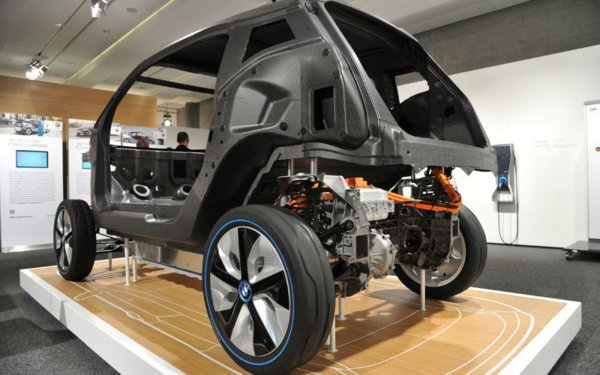
Although the company is still coy about exact pricing for the i3, I was told repeatedly, by senior people, to expect to be “pleasantly surprised.”
That means – surely- that the i3 will compete in the UK with a 2013, top-spec Tekna Nissan Leaf, which aside from any government grants costs £30,490. I think a bare-bones BMW i3 will come in above that but not much, while the range extender option might add another 10%.
Fully specced up, it will probably cruise comfortably above the most expensive Vauxhall Ampera, at £38,995. The benchmark for the i8, meanwhile, is an Audi R8, so that means £100k, give or take according to spec.
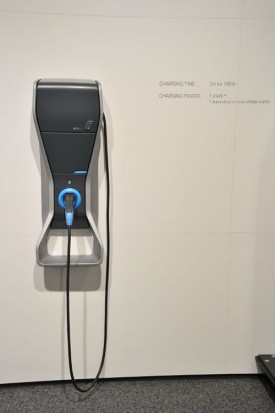
Ah, yes, the range extender. The Germans are not like the British when it comes to cars. They apply a systems engineering approach. Electric means electric Jah? You can’t then go and pollute it with a grotty petrol engine.
But sensibly caving into range anxiety, BMW is offering a range extender in the form of a two cylinder engine plucked from the Motorrad (motorbike) division and heavily modified to keep emissions down. This motor sends electricity to the batteries, it does not drive the wheels.
Confirmed range for the electric-only i3 is 130-160km (80-100 miles), doubling with the range extender and perhaps more importantly meaning that you can then think of driving from London to Liverpool and back again without conking out on the hard shoulder.
Top speed will be 150km/h, but the ‘happy’ cruising speed is said to be 120km/h, or 74mph.
There’s a whole pile of other noteworthy detail, such as the fact that BMW is training up a cadre of electricians to come and fit an all-weather charging box at your house, fully charging an i3 in 3 hours.
Running costs, and that plastic body shell
But beyond the fire and spark innovations, and with UK business users in mind, I was most impressed by BMW’s consideration of whole life costs. Warranty information was scant, but I was told that the batteries will be good for 150,000kms or ten years, at which point the cells will still be 80% effective. Meanwhile, the whole car is modular and replaceable/mendable, because it consists basically of an aluminium tray with batteries, a carbon fibre passenger cell, and then on top a very light weight plastic shell.
This last detail will be interesting to business users and private buyers alike. Not only won’t an i3 rust, but the outer plastic is flexible enough not to ‘ding’ like a pressed steel panel. If a bigger prang cracks a panel it can simply be replaced at low cost.
The plastic shell parts are the only ones painted, and come pre-painted, so goodbye to the UK’s insurance-industry scam around body shops and their use of the most expensive paint money can buy.
The story so far…
- The BMW i3 will travel 100 miles on electric-only power
- It’ll cruise at motorway speeds
- It will be super-safe, yet body panels are plastic
- Despite the batteries, it’s light weight
- It should cost £30-£40k
- Body repairs are 40% cheaper – so expect lower insurance premiums
- Handling should be ‘brilliant’
- But it does have a motorbike engine as a range extender
Underneath, the aluminium elements can be unscrewed and replaced, meaning that it’s not a massively expensive Bristol/Audi A2 situation where a seemingly insignificant shunt means a write-off.
Finally, I was shown a video in which a whole side section of the carbon fibre reinforced plastic passenger cell was cut out using a reciprocating saw, and replaced with an equivalent part that can be glued in. BMW claim a 20% reduction on life-time maintenance costs, and a 40% reduction on accident repair costs, of an i3 compared to a 118d. This should reduce insurance premiums for business and private users alike.
If any of that sounds a bit Heath Robinson, the i3 is set to attain a gazillion NCAP stars. I saw the crash dummie tests for myself, and believe me this car brings to ordinary folks what was previously only for Formula One.
Less attractive from the cost/ease of use point of view, is the fact that initially only a select few dealers will be qualified to take a reciprocating saw to your carbon fibre i3, while bespoke tyres are never cheap or in stock, something that Nissan Note users have discovered to their exasperation.
So, would you want one?
Although we weren’t able to drive the i3, it’s still possible to imagine answering the only meaningful question about the i3: would you want one?
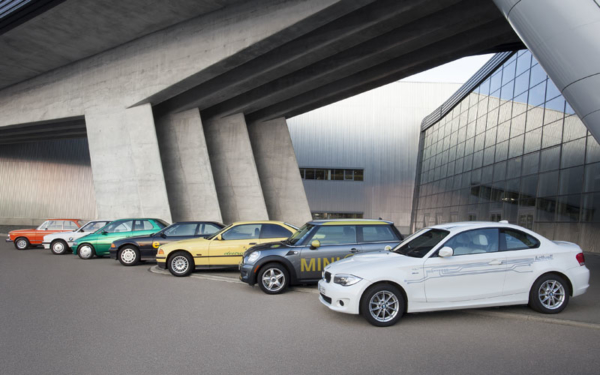
So far, BMW electric cars – the MINI-e and Active E prototypes than have been road tested to a selected, mostly American customer-base on a lease-only basis – have been thrillingly fast at acceleration, as only electric cars can be, and disconcertingly fast to decelerate if you lift off the gas. Unlike an ordinary automatic, there is no built-in creep, which might be a problem in the M25 crawl.
BMW started with the question: What would make a great BMW?
Where the i3 will be a breed apart is in dynamic appeal.
This is where at least some of the hoopla around a BMW electric car is warranted, bearing in mind that the Nissan Leaf and Vauxhall Ampera have been on the road for a while now. Instead of starting off with the question: what would make a good EV?, BMW started with the question: What would make a great BMW?
In fact that’s precisely why BMW ended up reinventing the entire process of car manufacturing, since to offset the extra weight of the batteries meant turning to carbon fibre for the body, because carbon fibre is half the weight of steel and just two-thirds the weight of alumnium. The i3 is not a small car, -think Qashkai/Evoque/Countryman- but total kerb weight is kept down to 1,250kgs.
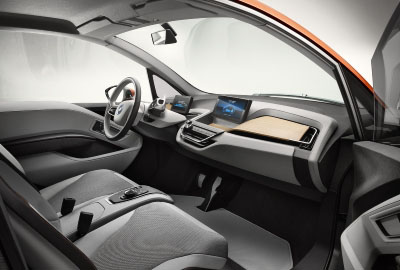
The i3 will handle brilliantly, I predict, because the battery weight is at the lowest point in the car’s architecture, and dead central. Ride quality will hopefully be excellent, on tall profile-tyred, large rims – the ones we saw equipped with Bridgestone 175/60 R19s, big in diameter but narrow in girth.
Poor packaging might be a weak spot for the i3. A bit like the MINI Countryman, the hatch aperture is quite small and the boot, with its tall floor to accommodate the electric motor underneath, is compromised. The passenger cell is going to feel very airy, luxuriously simple one could almost say, but will BMW have Honda Jazz-style magic seats or Skoda-like removable seats, given that most of the time drivers do not cart around three passengers?
Finally, if this vehicle really is an urban solution, is it too large? No doubt determined to distance themselves from Lilliputian offerings and the perception of austerity conveyed by, say, the Mitsubishi i-MiEV, BMW have made sure that the i3 screams superiority.
It is taller than an X1, has the track of a Seven Series, and the wheel base of a One Series.
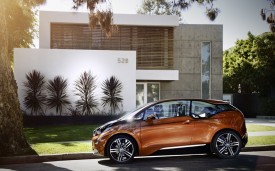
Like the MINI Countryman, and the Nissan Qashqai then, such dimensions will surely appeal to the status-obsessed UK, but what we don’t know is whether it will be ‘cool’ in the face of BMWs other products, to say nothing of competitor SUVs. Will the i3 be cool or will it appeal only because it eliminates petrol bills?
To begin with, I think there will be a higher caste of Park Lane hedge fund managers and celebrities who will buy the i3
To begin with, I think there will be a higher caste of Park Lane hedge fund managers and celebrities who will buy the i3, but it’ll take time to spread to Redbridge and Wolverhampton.
This is where the manufacturing revolution behind the i3 is more significant than whether or not the i3 meets sales its global sales targets in year one (and it might, taking into account Tokyo and Beijing and New York, and not just Basildon).
Until now no one has been able to mass-produce carbon fibre, which is why the stuff is so expensive whether it’s a dinghy spar, a fishing rod, a high end racing bike or the wing of a Boeing Dreamliner. Carbon fibre, until now, has meant semi-bespoke, slow production and high price tags.
BMW has brought secret processes to bear to go from carbon fibres thinner than a human hair to a finished car in an entirely automated process that will slash costs as production volumes rise. In other words they’re part-way towards scalability, to use the trendy word. They have vowed to bring the cost down to the level of conventional, steel car making, and perhaps even lower on a ten-year ahead horizon.
Let’s imagine a MINI or a 118d made entirely from aluminium and carbon fibre… that would be amazing
So for one moment let’s forget BMW’s i sub-brand.
Let’s imagine a MINI or a 118d made entirely from aluminium and carbon fibre, with the new three cylinder, petrol, twin-turbo screamer that’s going into the i8. It could be twice as dynamic, half the weight, and twice as many miles to the gallon as the existing products. I can’t hide my excitement. That would be amazing.
But I cannot myself imagine buying an i3.
Without a range extender it cannot go from London to Oxford and back without a charge, a trip I make weekly. The range extender is great, but not that great. It was essentially a reluctant, late-addition by BMW, for as they said themselves this week, the worst thing you can do to a very green car is to introduce a motorbike engine, and for the same reason this version won’t be for sale in the US, exactly where the range issue is most acute. So then you’re back to the 118d, already a very fine car.

As for the ultimate urban solution, I have never believed it consisted of four wheels rather than two, plus or minus public transport and walking. That’s why the BMW e-scooter is of great interest.
Besides, I already own a carbon fibre chassis mated to a hyper-efficient engine. It’s my French-made, Look 566 racing bike, and it runs on fruitcake and Lindt chocolate.







